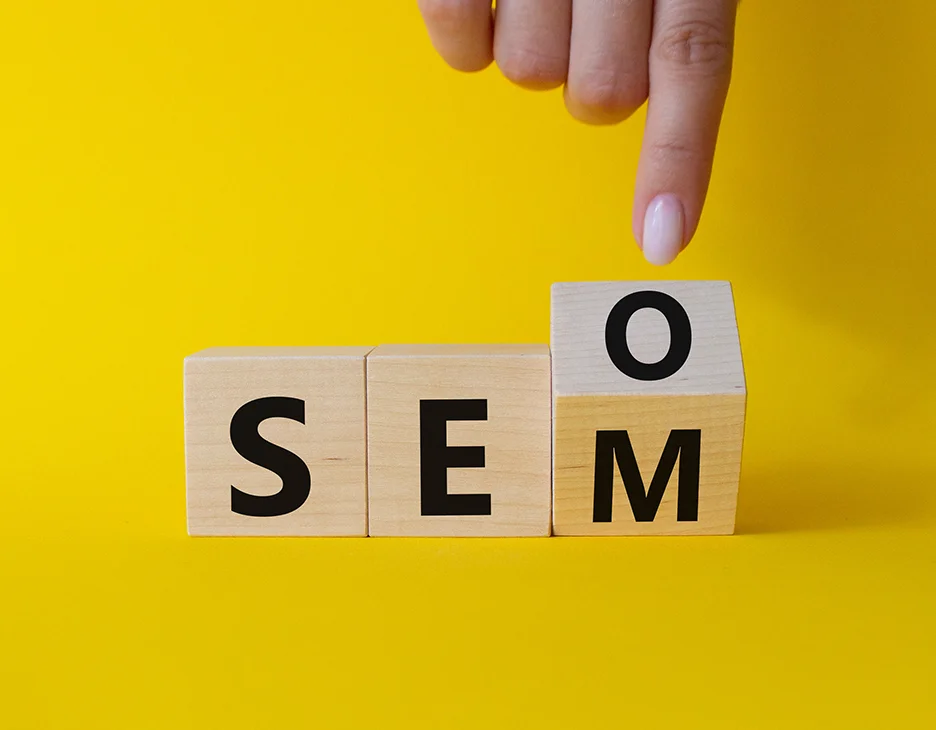What Is SEO? How Does It Differ From SEM?

Whether you are a new start-up business or are switching to digital marketing for the first time, there will be many factors to consider when creating a strategy. With so many channels, techniques and campaign types to choose from, how can you determine which would be the most beneficial for your brand?
Having spent many years supporting clients in their growth, we have worked with many brands who are unsure which route to take. SEO and SEM are two fantastic strategy types, but due to their slight differences, they are better suited to some businesses more than others. In our guide, we not only answer the question “what is SEO?”, but we’ll also introduce you to SEM and how the two methods differ from one another.
What Is SEO, How Does It Work & What Makes It Different From SEM?
It is thought that there are over three billion online searches every day, so in a world that has become obsessed with surfing the internet, how can you ensure that your business is seen? The process can be time-consuming but is relatively straightforward and offers a wealth of benefits, making digital marketing a key component in business growth.
If you are new to the terms SEO and SEM, it can all appear a little daunting, but this needn’t be a worry. Through familiarising yourself with the factors that contribute towards successful campaigns, you will quickly begin to reap the benefits. With this in mind, we are going to answer the following questions:

What Is SEO And How It Works
So, let’s start from the beginning, what is SEO and how it works. SEO stands for Search Engine Optimisation and is the process of increasing your organic ranking on search engines, most commonly Google. Each search engine uses clever bots to collect all of the information on your website before it is added to an index; this is otherwise known as crawling. From here, search engine specific algorithms begin to analyse each webpage, checking each component against a number of factors to determine your organic ranking. The websites that prove the most beneficial to the search engine users and comply best with the algorithms will land a place at the top of the first results page. In technical terms, these pages are called Search Engine Results Pages, which you may know as SERPs.
Although effective SEO does take time and patience, the benefits make this strategy a highly effective way to increase traffic and conversions. Just some of these excellent benefits include the following:
- Begins to build trust with your target audience and credibility in your industry as it shows you have put work in to prove your position in the market.
- The techniques used in SEO are designed to enhance user experience, so through implementing these, you will find that your website performs far better and outshines your competitors.
- As your organic ranking is based solely on the marketing efforts you put in, SEO does not involve paying for ads like other campaigns such as Pay Per Click (PPC).
- Once you have secured your position on page one, SEO offers a long-term strategy, so all you need to do is focus on maintaining your high ranking.
High performing SEO involves several different components, including both a tailored marketing campaign and a fully optimised website. Here is all of the information you need to know about each.

What Is SEO Marketing?
SEO marketing features several different elements which are fused to create a campaign. Typically, SEO campaigns run on a month-to-month basis, meaning that regularly tracking your process is essential in determining which areas you should focus on for the upcoming month.
One key aspect of SEO marketing, otherwise known as off-page SEO, is backlinks. To generate backlinks, you must complete a process called link building, which can involve adding your site to directories, guest blogging on other sites and getting featured on publications. The key to successful link building is to focus on quality over quantity. It will be far more effective to build a few high-authority, high-quality backlinks to your website than lots of smaller ones that may not offer the traffic you need.
Along with backlinks, another key factor that many do not consider is your social media activity. In recent years, social media advertising has become more important than ever, helping you to create easy backlinks back to your website, boost engagements and encourage more traffic. Why? Because social channels allow your target audience to discuss your products or services, get to know your brand on a personal level and interact with your business.
What Is An SEO Website?
In order to begin an SEO campaign, you must ensure that your website is optimised, which is also known as on-page SEO. The two come hand-in-hand, so through spending time during the initial stages to perfect your on-page SEO, your marketing efforts will naturally become more successful.
You may be thinking, what is an SEO website? An SEO website relates to a site that has been internally optimised to meet the latest algorithms, making it more search engine friendly. These factors are all elements that have been proven to enhance user experience, so when they are used, the bots mentioned previously will recognise that your site is of importance and, in return, reward you with a higher ranking.
Many different components go into making a website optimised for search engines, and the first to tackle should always be keywords. Sites such as Google Keyword Planner and SEMrush allow companies to track down what their ideal customer is searching for in order to find their services and/or products. Simply search the various names that can be used for your products or services, and you will be provided with a wealth of opportunities. These will then need to be incorporated into your website through a content marketing strategy.
Along with keywords, other aspects that you will need to consider for successful on-page SEO include title tags, meta descriptions and heading tags. For more information on the must-haves when it comes to on-page SEO, take a look at Search Engine Journal.
What Is SEM?
As opposed to focusing on optimisation only, SEM relates to marketing strategies that combine SEO with paid campaigns; the most common platform for this is Google AdWords. Not only this, but many businesses also include other paid advertising methods such as online listings, depending on how far their budget can stretch.
Due to the nature of SEM, this strategy offers immediate results, but as you will be paying for your campaigns, ensuring that you keep an eye out on their progress is essential. For example, if you were to create a PPC marketing strategy on Google AdWords, it will cost each time that a user clicks your ads. This means that you will need to analyse which terms your ads are showing for to ensure that you are capturing relevant searches and not wasting money. For those paying for a listing, on the other hand, you are likely to be charged a monthly fee for your advertisement to remain visible on the chosen listing site. Most listing sites offer different packages, with the most expensive offering the most visibility. This makes it ideal for smaller businesses who want to start with more affordable options and then scale up as they grow.
One of the most significant benefits of SEM strategies is that they offer more flexibility if you want to test different methods. Ads can be turned off if they do not appear to be working and altered whenever you wish to meet demand. You will also be able to change what audiences you target, which pages on your site the ads direct to and how much money you want to spend pushing each area.
![]()
What Is The Main Difference Between SEO and SEM?
Now that you are familiarised with the different marketing methods available to your business, you may be wondering what is the main difference between SEO and SEM? This answer is straightforward, and you may have guessed from the explanations above – SEO is an organic strategy, whereas SEM is a paid strategy. Although both are designed to help your website appear in search results, drive traffic, and target your keywords, choosing which one you use will depend on many factors, such as the size of your business and your budget.
It is important to keep in mind that successful SEO is a process, which means that SEM will offer you faster results. For a new start-up business, it may be beneficial to trial paid ads to promote your brand while you work on boosting your SEO. When you begin to attract customers, you can then lower the amount spent on ads and focus more time on organic ranking. Depending on the geographical location, how long your SEO will take to begin generating a return will slightly differ. If you opt for local SEO targeting only your local areas, this will inevitably be quicker than national SEO, which is ideal for those who do not want to be tied down to a specific location.
Once established, many businesses opt for a combination of both strategies, opting for ongoing SEO services but then running paid ads during quieter periods or to push a new product or service.
Maximise Your Brand Exposure Through Digital Marketing!
Regardless of the marketing strategy you opt for, whether this is SEO only or a combination of campaigns through SEM, consistency will be key. It is far more effective to spread your marketing efforts over a period of time than attempting to complete everything in one day, for example. Search engines favour consistency as it allows them to recognise you as a business that continues to provide helpful information to its users. Although it may seem tedious in the initial stages, we promise it will be worth the extra time spent!
















